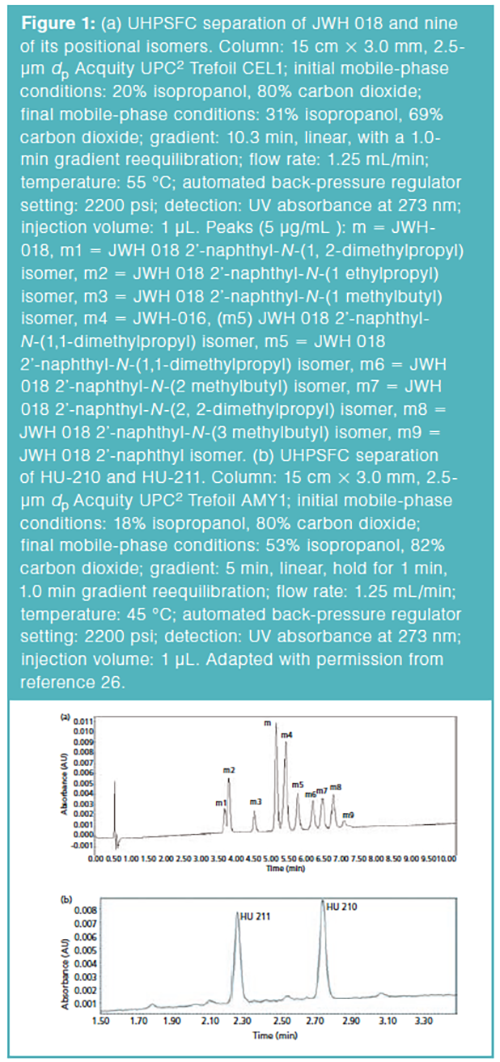Moving Gas Chromatography Forward
LCGC Europe
Is gas chromatography a mature technology? LCGC Europe spoke to Ronda Gras about a range of GC projects she has been working on to extend the scope of the technique, including a multi-hyphenated approach combining three modes of detection, a miniaturized micromachined GC system, and a novel in situ method to detect carbon dioxide in various matrices by incorporating 3D-printing technology in a FID.
Is gas chromatography a mature technology? LCGC Europe spoke to Ronda Gras about a range of GC projects she has been working on to extend the scope of the technique, including a multi-hyphenated approach combining three modes of detection, a miniaturized micromachined GC system, and a novel in situ method to detect carbon dioxide in various matrices by incorporating 3D-printing technology in a FID
Q. You recently developed a multi-hyphenated strategy combining three different modes of detection: ultraviolet (UV) spectroscopy, a flame ionization detector (FID), and mass spectrometry (MS). Why did you think this multi-hyphenated approach was necessary?
A: This research project was initiated to address the constraints associated with MS detection and separation challenges (1). By combining selective detectors, such as a UV detector with a mass spectrometer, we sought to advance a more comprehensive, accurate system capable of identification and quantification of analytes with a faster analysis time. The FID was incorporated for ease of quantification. We hold the view that multi-hyphenation is an effective and complementary strategy to enhance separation processes, such as multi-dimensional gas chromatography (MDGC) and comprehensive two-dimensional gas chromatography (GC×GC)
Q. What were the main obstacles you had to overcome and how did you overcome them?
A: There were three main challenges: First, preserving the chromatographic performance of high-resolution gas chromatography when using numerous inter-column connections. Second, performing flow management to achieve consistent and comparable retention times for all three detectors in this configuration, two detectors are at atmospheric pressure and one is under reduced pressure. Third, reconciling the differences between different chromatographic control and data systems. To overcome these challenges we used highly accurate, advanced pneumatic electronic flow controllers, low volume and inert microfludic inter-column connectivity devices, and used two independent computer platforms for data collection.
Q. This strategy was achieved by successfully hyphenating a user-selectable multi-wavelength diode array detector (DAD) featuring a positive temperature coefficient thermistor (PTC) as an isothermal heater to the gas chromatograph. What were the advantages of this approach?
A: We repurposed a DAD designed for LC for use with GC (1). The novelty of this approach is that a DAD in GC offers some key advantages, including the ability to acquire spectra in real time, high frequency sampling of up to 200 Hz, spectra free of solvent interferences because helium does not absorb over the wavelengths measured, and the capability to monitor eight wavelengths simultaneously over a wavelength range from 190 nm to 640 nm.
To realize the benefits of this new gas phase detector, we must have an effective heat management system. To achieve this, we innovated the use of PTC for use as a heating device, because it is compact, self-limiting, self-regulating, and has a low-voltage requirement with options for either AC or DC (2).
Q. What benefits does this multi-hyphenated system offer the analyst and do you see it being used in any particular applications?
A: This system offers improved accuracy in structural elucidation for target analytes and enhanced analytical throughput. With three detectors, in essence, three analyses are being conducted simultaneously. This approach is highly capable and reduces costs. The platform has a very wide applicability. The system has been used for a variety of applications, including volatile organic compounds (VOCs), petrochemical, and chemical applications (1).
One interesting example is the measurement of aromatics, such as benzene in hydrocarbons. Here, we can definitively confirm the presence of benzene in a complex matrix such as gasoline with both mass spectrometry and DAD in a single analysis. (1) This provides improvements in analytical efficiency, accuracy, and expands the capability of the analytical system.
Q. Were there any results in this research project that surprised you?
A: Once implemented, I was surprised how reliable and straightforward the platform is to operate. The availability of data from UV detection was highly useful to support mass spectrometry results.
Q. You recently developed a method using a micromachined GC system with universal and selected detectors for targeted volatile compound analysis. Can you tell us more about this research?
A: We are evolving a strategy for using selective detectors to lessen the burden on separation (3). Selective detectors offer additional chemical information about the molecule functionality, simplify the quantification process, and can significantly improve the speed of analysis. Additionally, positive detection from two selective detectors increases the accuracy of the analyte measurement. The long-term goal of the chromatography community is to miniaturize the footprint of the analytical platform. This research is an effort to demonstrate miniaturization without compromising analytical capabilities. We demonstrated that scalability of analytical capability is relevant. Future GC systems would benefit from a compartmentation or a modularization approach, depending on the needs of the analysis. This system aims to be used with molecules with a high degree of volatility in complex matrices, such as those found in fugitive emissions, indoor air quality, and off gases from various matrices.
Q. You also published research this year involving in situ methanation with flame ionization detection for the determination of carbon dioxide in various matrices. What matrices did you investigate and what were your main findings?
A: We sought to improve chemical analysis by incorporating metal 3D-printing technology with catalysis in a flame ionization detector jet (4). The novelty of this strategy is that the jet now has double duty to function as a conventional hydrogen flame jet and also as a single-stage microreactor for methanation to convert carbon monoxide and dioxide to methane. By taking advantage of the slight restriction generated by the 3D-printed jet, we implemented a novel post-column backflushing strategy using only the detector fuel gas, without additional hardware to improve reliability and throughput of the analytical system.
The main challenge of this approach was designing a jet configuration with an appropriate catalyst for methanation. Operational conditions, such as temperature, residence time, and air-to-fuel ratios are critical for conversion efficiency and to preserve peak fidelity. Avoidance of catalyst contamination are important for longevity.
It is recognized that carbon monoxide and carbon dioxide are highly common analyses across many applications such as fuel cells, fumigants, VOCs, and carbon emissions. In one application, we examined indoor air quality because increased carbon dioxide can result in reduced cognitive functions.
Q. You also worked on a project using flow-injection gas chromatography with sulphur chemiluminescence detection for the analysis of total sulphur in complex hydrocarbons. What benefits does this technique offer the analyst?
A: This new approach allowed total organic sulphur compounds to be detected accurately at ultra-trace levels in a record time of 10 seconds (5). By leveraging the compound-independent calibration or equimolar response for sulphur offered by the sulphur chemiluminescence detector, this can be achieved. With the high selectivity of the sulfur chemiluminescence detector, a complex liquid hydrocarbon matrix, such as gasoline or diesel, can be analyzed directly and the need for any time-consuming sample preparation can be eliminated. Furthermore, the overall detection of the total sulphur approach is enhanced, because all sulphur compounds are represented as a single band from the flow-injection strategy where no separation process is involved.
Q. Are there any recent advances in sample preparation in GC that are benefitting analysts?
A: Sample preparation remains an important step for gas chromatography. An appropriate sample preparation strategy improves system selectivity, detectability, and cleanliness. Recently our team worked on a micro piston liquid-liquid (µLLE) extraction technique (6). The strategy of using a micro-piston extraction offers high extraction efficiency with fast extraction speeds for analytes amenable for liquid-liquid extraction. Small volumes as low as 200 microliters can be used. This can significantly reduce waste generated.
Numerous other techniques such as sorptive enrichment, dynamic and static headspace, and many others are all relevant and critical for measurement success (7, 8, 9). Automation and robotics can improve productivity and reliability.
Q. GC is often regarded as a mature technology. Do you think there is scope for more research to advance GC as an analytical technique?
A: While GC has been perceived as a mature technology, challenges remain, particularly for ultra-trace analysis with complex matrices. With the inherent advantages of the separation process, gas chromatography-based methods will continue to provide more selective and accurate quantification for analytes of interest.
Further areas for research include-but are not limited to-more effective sample introduction techniques, new column stationary phases and formats, new temperature control strategies and heating management systems, advances in passivation techniques for sample flow-path inertness, and new detector developments. Microfluidic-enabled chromatography for MDGC and GC×GC will also play a vital role in the future. Miniaturization of analytical instrumentation will be a positive change. Improving the speed of analysis, sensitivity, and selectivity are key. More than a quarter million analytes are amenable to gas chromatography. The technique in its current format is significant and prevalent. Gas chromatography is inspiring, impactful, and timeless!
References
- R. Gras, J. Luong, P.R. Haddad, and R.A. Shellie, J. Chromatogr. A1563, 171–179 (2018).
- R. Gras, J. Luong, M. Pursch, and R.A. Shellie, Anal. Chem.90, 6426–6430 (2018).
- R. Gras, J. Luong, and R.A. Shellie, J. Chromatogr. A1573, 151–155 (2018).
- J. Luong, Y. Hua, R. Gras, and M. Hawryluk, Anal. Methods10, 1275–1279 (2018).
- Y. Hua, M. Hawryluk, R. Gras, and R. Shearer, J. Luong, J Sep Sci.41, 469–474 (2018).
- J. Luong, R. Gras, K. Gras, R.A. Shellie, Can. J. Chem.93,1283–1289 (2015).
- N. Ochiai, K. Sasamoto, F. David, P. Sandra, J. Agric. Food Chem.66(28), 7249–7255 (2018).
- Li Zhang, E. Gionfriddo, V. Acquaro Jr., J. Pawliszyn, Anal. Chim. Acta1031, 83–97 (2018).
- K. Dettmer-Wilde, W. Engewald, Practical Gas Chromatography, 1st Ed. (Springer-Verlag Berlin Heidelberg, 2014).

Ronda Gras is an associate R&D Scientist of Analytical Science, Core R&D of the Dow Canada. Since 1991, Gras has published more than 100 internal publications and more than 50 scientific publications in peer-reviewed journals. She holds three patents and is a co-author of other patent applications from various projects. Gras is an active member of the Analytical Science’s Global Gas Chromatography Technology Network.

New Study Reviews Chromatography Methods for Flavonoid Analysis
April 21st 2025Flavonoids are widely used metabolites that carry out various functions in different industries, such as food and cosmetics. Detecting, separating, and quantifying them in fruit species can be a complicated process.
University of Rouen-Normandy Scientists Explore Eco-Friendly Sampling Approach for GC-HRMS
April 17th 2025Root exudates—substances secreted by living plant roots—are challenging to sample, as they are typically extracted using artificial devices and can vary widely in both quantity and composition across plant species.
Sorbonne Researchers Develop Miniaturized GC Detector for VOC Analysis
April 16th 2025A team of scientists from the Paris university developed and optimized MAVERIC, a miniaturized and autonomous gas chromatography (GC) system coupled to a nano-gravimetric detector (NGD) based on a NEMS (nano-electromechanical-system) resonator.
Miniaturized GC–MS Method for BVOC Analysis of Spanish Trees
April 16th 2025University of Valladolid scientists used a miniaturized method for analyzing biogenic volatile organic compounds (BVOCs) emitted by tree species, using headspace solid-phase microextraction coupled with gas chromatography and quadrupole time-of-flight mass spectrometry (HS-SPME-GC–QTOF-MS) has been developed.

.png&w=3840&q=75)

.png&w=3840&q=75)



.png&w=3840&q=75)



.png&w=3840&q=75)












